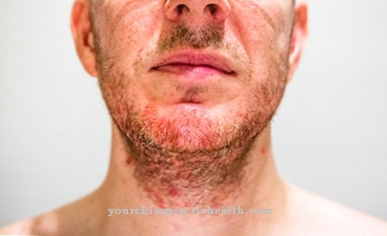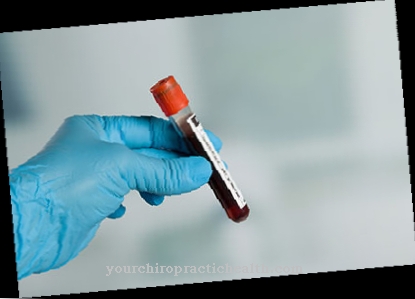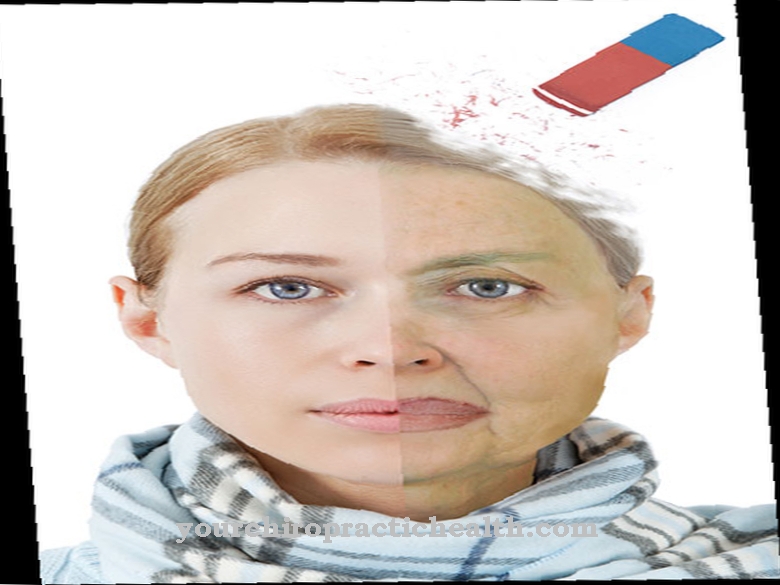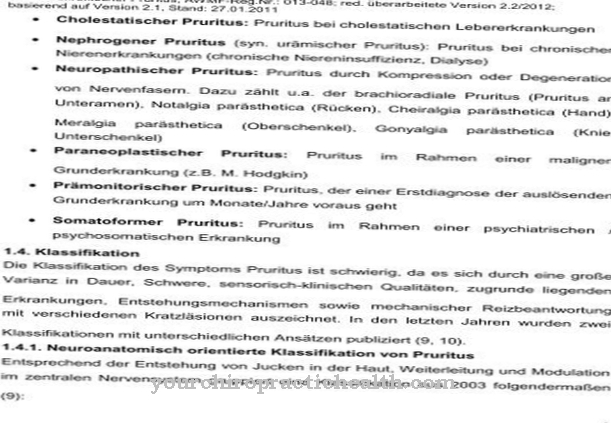A Skin infection describes the damage to the skin caused by defense reactions of the body to certain pathogens. Bacteria, fungi, viruses and parasites can be considered as triggers. There are a multitude of different dangerous skin infections.
What is a skin infection?

© David Pereiras - stock.adobe.com
Skin infections refer to infections of the skin and the areas of the body associated with them, including infections of the sebum glands, hair follicles and so on. Accordingly, skin infections are not limited to the dermatological picture, but can go far beyond that. In a broader sense, nail bed infections and, for example, foot and nail fungus are also included.
A skin infection is always caused by a pathogen, with bacteria being the most common cause. In addition, a distinction must also be made between diseases that only affect the skin or whether the skin infection is a symptom of another disease. Systemic diseases, for example, are also frequently associated with skin infections.
The infections can be very different. They range from slight skin irritation to severe necrosis with pus formation. Local skin infections are not uncommon. For example, acne and the occasional pimple formation affect almost everyone. A diaper rash affects almost every baby at least once in their lifetime.
causes
There are basically four different types of pathogen in skin infections: bacteria, fungi, viruses and parasites. The majority of all infections can be traced back to the fact that pathogens get into the skin through the smallest injury. For example, streptococci or staphylococci can lodge and lead to an infection. Individual sweat or sebum glands and hair follicles can also be affected, which then also leads to a (local) infection.
Boils are also used in this context. If there is also no pus formation inwards, abscesses form, which are also associated with skin infections. Acne is often caused by other types of bacteria, mostly Propioni bacteria.
In principle, most bacteria can lead to purulent infections in the event of a skin injury, as the bacteria lead to inflammation and immune reactions through their metabolic products. These infections can remain superficial or penetrate deeper into the tissue. Above all, bacteria trigger inflammation of the skin glands, purulent infections, acne and the sore throat. But cellulite (not to be confused with cellulite!) And larger wound infections are also caused by bacteria.
Viral pathogens are the cause of chickenpox, warts, measles, shingles, genital warts and herpes, among other things. The viral pathogens often get into humans through body fluids. Among the fungi there are numerous species that are already at home in the human skin flora. Usually they only become a fungal infection if the immune system of the person concerned is (permanently) damaged or the skin flora has changed significantly.
Then, for example, various yeasts and other skin fungi can lead to fungus lichen. But fungi can also settle in the body, for example in the case of oral thrush. The most prominent example is athlete's foot (which can also affect the hands, scrotum and other areas). Thread fungi are responsible here. Fungi can also be in or under the nail.
Parasites are to be mentioned last and are the rarest causative agents of skin infections. Lice, bed bugs and the itch mite are the most common pathogens here. The infection (or the inflammatory reactions) are secondary in the case of lice and bed bugs. In the case of scabies, the infection occurs because of the parasite in the skin.
Sometimes skin infections arise due to opportunistic infections: The weakened skin (for example due to dryness, illness or an injury) then becomes the local focus of infection more by chance. It should also be noted that people have different skin thicknesses and that the skin flora in some people almost favors certain infections.
Skin infections must also be distinguished from infections that are most likely to occur due to skin injuries. Examples are tetanus and rabies.
You can find your medication here
➔ Medicines against redness and eczemaSymptoms, ailments & signs
Skin infections always show up as a change in the complexion of the skin. Usually redness occurs. Itching and uncomfortable sensations in the affected areas are also common.
Otherwise the symptoms are very different. Bacterial infections can lead to pus formation, abscesses, extensive damage to the skin and so on. The skin can also be completely destroyed as a result of local necrosis.
Viral infections, on the other hand, are never associated with the formation of pus or abscesses and can often be better assigned. In particular, the viral skin infections that lead to the so-called childhood diseases have a clear symptom picture. These include, for example, chicken pox and measles.
Fungal infections vary widely. Superficial skin infections are usually associated with the formation of spots. These can be of different sizes and more or less raised. Sometimes the pigments in the skin are destroyed, which can lead to discoloration. Fungal skin infections are not always associated with itching.
Usually they are completely symptom-free (with the exception of the aesthetic change). Foot and nail infections, on the other hand, are often associated with itching and often mean a very penetrating odor development. The parasite infestation on the skin always leads to itching. In the case of scabies, it can be particularly agonizing.
A few examples of the classic symptoms of known skin diseases should be listed here. For example, acne always means the formation of pus in the sebum glands (usually on the face or upper torso), which may be associated with pain. Large abscesses (e.g. after severe wounds) can lead to immense pain and necrosis.
Cellulitis is accompanied by severe reddening of the skin, but otherwise it can also be symptom-free. Hand, foot and mouth disease can lead to blistering of the mouth, skin irritation on the hands and feet and loss of appetite. Young children in particular are affected by the viral infection.
The scabies shows up through bored tunnels in particularly warm and well-perfused areas. Sometimes it can be seen as a small point under the skin. The itching becomes worse, especially at night.
Complications
Complications in the case of a skin infection are generally rare. Most skin infections can be regarded as harmless with adequate treatment, although the treatment can often be protracted.
Complications are at best to be feared in severely immunocompromised patients and in large-scale infections with pus and abscess formation. For example, a bad immune system can always lead to a worsening of an actually harmless clinical picture. Bacteria and other pathogens can then multiply faster and cause more damage even faster. In the case of bacteria, potentially fatal sepsis can occur under the worst of circumstances. This can also be caused by particularly large abscesses.
If a part of the body is too deeply penetrated by an infection that may have originated on the skin, an amputation is also necessary in rare cases.
The complications of a skin infection in most cases depend on whether the infection is local or whether it is spreading. For example, a single boil or pimple is unlikely to cause complications, while fungal infections can.
A frequent consequence of skin infections is also that the affected areas of the skin are attacked and subsequent infections occur. If no action is taken, there is a risk of loss of the intact skin. Overall, however, complications are rare. It should be noted that particularly susceptible skin types are not well prepared for certain skin diseases (especially fungal infections) and those affected suffer from them again and again.
Further complications depend on the exact disease.
When should you go to the doctor?
Changes in the skin (with the exception of single pimples or a slight reddening) are always a reason to consult a doctor. This is not only the case because the lesions on the skin can represent skin infections. Rather, there are also various skin changes that indicate other diseases.
For example, with a Lyme disease infection, typical circles appear on the skin. But other diseases from the idiopathic group of dermatological diseases can occur and require clarification. A typical example here is neurodermatitis.
Occasional rashes can occur due to allergen exposure. Here, too, it is worth repeating and clarifying. In addition, some rashes are related to infectious diseases. For example with HIV, syphilis and the flu.
A family doctor can be the first point of contact. Above all, he will recognize clear clinical pictures well. If the results are not clear, a dermatologist can help.
Warning signals that indicate a visit to the doctor are, for example, hardened areas of the skin, severe thickening, changes in sensation and circulatory disorders.
Doctors & therapists in your area
diagnosis
The diagnosis is usually made by looking at the skin and, if necessary, by taking tissue samples and smears. In most cases, however, a visual diagnosis is sufficient to at least determine the type of pathogen. An anamnesis usually arises when the skin changes are infectious but cannot really be assigned.
If there are abscesses and similarly serious damage, imaging procedures may have to be used. In rare cases it is necessary to know the exact type of pathogen (for example, when the use of broad spectrum antibiotics is not advised). Then laboratory diagnostic examinations are used. Parasites can usually be identified quickly.
Treatment & Therapy
With the exception of viral pathogens, treatment is cause-oriented. This is how bacteria are treated with antibiotics. There are fungicidal agents against fungi that are either applied externally or used through tablets. Parasites can also usually be combated with creams and ointments.
In some cases it is necessary to work directly on the skin. So the treatment also consists in establishing adequate hygiene of the affected area. Abscesses are usually punctured. Severe necroses usually have to be removed surgically. Amputations can be considered if there is extensive tissue atrophy with a risk of sepsis.
The treatment in the case of a skin infection can take a long time, for example if it is inflammatory acts or severe cases of fungal infection. The therapy usually consists of a combination of medication and certain actions that are supposed to protect the skin. This can mean using certain detergents, avoiding certain substances and much more and must be determined individually.
In some cases (especially with fungal infestation) hair removal can also be useful in order to better combat possible reserves of the pathogen. This is also useful for head lice and pubic lice. In the case of viral pathogens, however, treatment is symptomatic.
Outlook & forecast
Skin infections have a good prognosis in most cases. The pathogens can be easily identified in medical treatment through targeted tests and then treated. Therefore, within a few weeks, a large number of patients experience an alleviation of symptoms and then freedom from symptoms.
Basically, the sooner a treatment is possible, the better the chances of recovery. With some pathogens, the skin changes improve even without drug treatment. A good body wash and changing clothes can help alleviate the symptoms.
However, depending on the cause of the skin infection, there may be deterioration in health without treatment. The germs, viruses, fungi or bacteria can multiply and spread further on the skin within a short period of time. In addition, there is an increased risk of pathogens entering the organism through open wounds. In severe cases, the patient is at risk of blood poisoning and thus a fatal course of the disease.
It is therefore important to determine the cause of the present skin infection for a good prognosis. A decision can then be made on the need for medical treatment based on the test results. For some infections, therapies based on natural healing are completely sufficient to achieve recovery.
You can find your medication here
➔ Medicines against redness and eczemaprevention
Preventing skin infections is difficult. In the case of infections that develop through wounds, wounds and scratches should be cleaned quickly. This should be done with sterilizing agents if possible. Covering the injured area makes sense.
Furthermore, the skin flora and skin health can be supported. Dryness on the skin should be avoided. Sufficient fluids and skin care creams can help here. In addition, the absorption of vitamins A and E have a positive effect on the skin's ability to regenerate.
Particular attention is also paid to washing the skin. There is a lot of discussion here about how much soap and other agents a skin flora can tolerate. This seems to be different for everyone. For example, people with very sensitive and often damaged skin can try to use less soap when showering. Among other things, this maintains the skin's natural acid protection and can support the natural skin flora (which compete with invading pathogens).
Aftercare
In the case of a skin infection, the options and measures for follow-up care in most cases very much depend on the exact infection, so that no general prediction can be made here. As a rule, skin infections can be treated relatively well, although an early diagnosis is always necessary to prevent further complications or symptoms. The earlier a doctor is consulted for this disease, the better the further course is usually also.
Most infections on the skin are treated by applying creams or ointments. The person concerned should pay attention to a regular application and also to the correct dosage of the means. If antibiotics or other medications are prescribed, these must also be taken and dosed regularly.
When taking antibiotics, it should also be noted that they should not be taken together with alcohol, otherwise their effect will be significantly weakened. In severe cases, talking to friends or family is also very advisable to prevent psychological upsets or depression. Contact with other affected persons can also be useful. In most cases, a skin infection will not reduce the life expectancy of those affected.
You can do that yourself
For skin infections that are temporary and not showing any symptoms, it is best to keep the affected areas clean. In addition, they should not be touched unnecessarily in order to accelerate the healing process.
In the case of pus formation, moist, warm compresses can cause the pus to break out more quickly, which leads to relief more quickly. In principle, people affected by skin infections can take any action that is intended to promote skin health and the immune system. This applies above all to a diet rich in vitamins and minerals.
In addition, individual inflammations of the skin (pimples, inflamed glands, etc.) can be countered with drying and antiseptic agents. Examples are zinc ointments and turpentine oil. However, with remedies like these, their use should be discussed with a doctor.
Fungal infections can be temporarily fought with vinegar. However, this does not remove the spore reserves that have already been created. Large skin changes, such as those that occur in the case of a large abscess or severe fungal attack, on the other hand, cannot be treated yourself. A full visit to the doctor is a must here.














.jpg)













